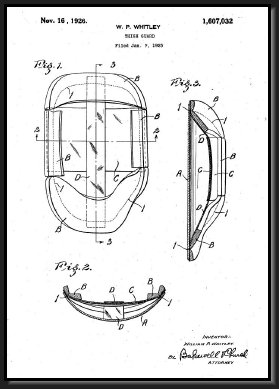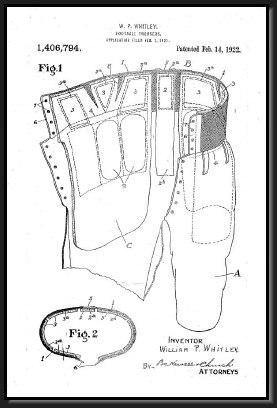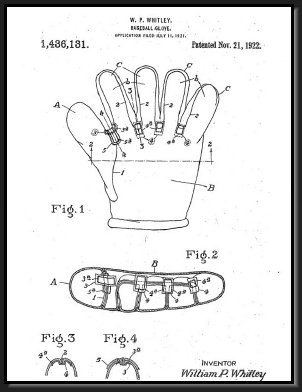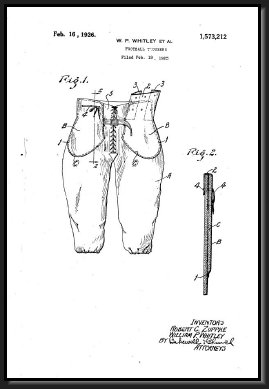

Questions or comments? Please email me at:






In 1902, Rawlings Sporting Goods introduced a line of "Foot Ball Wearing Apparel," called "Whitley's Foot Ball Armor." According to Rawlings' company history, Whitley's Armor marked the introduction of shoulder pads into American football. A surviving example has yet to surface, but thanks to a recently discovered advertisement, we now have illustrations of this unique football innovation. Further research has led us to answer questions raised by the advertisement. Who was William Whitley? Did Rawlings really invent football shoulder pads?
Whitley's Foot Ball Armor
Chris Hornung
January 29, 2017
William P. Whitley
Native Missourian William P. Whitley began his career in sporting goods in 1884 at the age of 18, when he joined his brother Montifer as a clerk at C. & W. McClean, a St. Louis fishing and sporting goods retailer. William would spend the next ten years at McClean as a clerk and salesman. Following a short stint with Simmons Hardware Company in 1894, William took a job as a sporting goods buyer for E.C. Meacham Arms Company in 1895. While at McClean, William met George H. Rawlings, who was McClean's gun department manager between 1884 and 1887.
George H. Rawlings (32) and his younger brother Alfred (28) ventured into the sporting goods business themselves in 1887, founding Rawlings Brothers, on the corner of Chestnut and 8th street. Similar to most sporting goods retailers of the day, Rawlings Bros. sold hunting and fishing gear, while also carrying athletic goods for baseball, boxing, and other athletic goods.
On March 1, 1893, Rawlings Brothers' store was destroyed by an accidental gunpowder explosion. Several employees and passerbys were injured in the blast, which spewed broken glass and pieces of guns and sporting goods into the street. With a total loss of $35,000, George and Alfred shut down Rawlings Brothers after 6 years in business. After a short stint in Chicago working for another sporting goods retailer, Thorsen & Cassidy, George returned to St. Louis to manage E.C. Meacham's gun department in 1897.
On March 1, 1893, Rawlings Brothers' store was destroyed by an accidental gunpowder explosion. Several employees and passerbys were injured in the blast, which spewed broken glass and pieces of guns and sporting goods into the street. With a total loss of $35,000, George and Alfred shut down Rawlings Brothers after 6 years in business. After a short stint in Chicago working for another sporting goods retailer, Thorsen & Cassidy, George returned to St. Louis to manage E.C. Meacham's gun department in 1897.
Rawlings Brothers
Later in 1897, when E.C. Meacham was acquired by Simmons Hardware, George Rawlings left Meacham founded a new sporting goods manufacturing company, Rawlings Sporting Goods, with Charles W. Scudder. Scudder, who had experience working in the hardware and grocery business, financed the venture and assumed the role of president. George would serve as secretary and manager. It's unlikely Alfred Rawlings played any role in the company, for he remained in Minneapolis until 1901. he returned to St. Louis and died less than a year later at the age of 42.
One of George Rawlings' first acts as manager was to hire William Whitley as a salesman. Unlike Rawlings Brothers, Rawlings Sporting Goods was organized as a manufacturing company, and William would soon show his prowess in developing new innovations in athletic gear. William was issued at least six U.S. patents for athletic equipment, all of which he assigned to Rawlings Sporting Goods Company.
One of George Rawlings' first acts as manager was to hire William Whitley as a salesman. Unlike Rawlings Brothers, Rawlings Sporting Goods was organized as a manufacturing company, and William would soon show his prowess in developing new innovations in athletic gear. William was issued at least six U.S. patents for athletic equipment, all of which he assigned to Rawlings Sporting Goods Company.
So did Whitley invent the football shoulder pads? Until another earlier contender is discovered, our conclusion is.....yes. The advertisement is the earliest known image of an apparatus designed for the protection of both the collarbone and shoulders. In comparison, A.G. Spalding's 1902 line of protective football pads was limited to their "Improved Sole Leather Pads for Shoulders" and sew-on "Leather Covered Pads." A. L. Reach did not carry any protective football pads in their 1902 catalog, and Stall & Dean Fall & Winter catalogs show that their line was limited to sew-on pads as late as 1909.
Rawlings Sporting Goods




Rawlings Sporting Goods Ad, The Sporting Goods Dealer, November 1903
St. Louis Directory, 1889
Kokomo Daily Tribune, March 1, 1893
Base Ball Glove, 1911
Base Ball Mitt, 1912
Football Trousers, 1922
Baseball Glove, 1922
Football Trousers, 1926
Thigh Guard, 1926
By 1908, George Rawlings had left Rawlings Sporting Goods and was listed as a salesman for Geller, Ward, & Hamner in the St. Louis directory. The reason for his departure is unknown. He died in 1909. William Whitley's career with Rawlings Sporting Goods, however, would span three decades. In 1908, Whitley was named Vice President, a position he would hold until the late 1920's.
The November, 1903 issue of "The Sporting Goods Dealer," included a Rawlings Sporting Goods Company advertisement for Whitley's Foot Ball Armor, which holds clues to Whitley's thought process in creating the new line. In 1900, sporting goods manufacturers introduced football pants with cane ribs inserted between fabric to provide a rigid barrier at the thigh. The design was an instant success, and most football players switched from quilted pants to these new "armored pants" shortly thereafter. Whitley's Armor appears to have borrowed from this new design and reused it to protect the collarbone. The "Armor Jacket" and the "Armored Combination Suit" were smock vests and union suits respectively with cane ribs sewn into the jackets at the collarbone and molded leather caps attached at the shoulders.
Whitley's Armor's Place in the Evolution of Shoulder Pads
Rawlings Sporting Goods Ad, The Sporting Goods Dealer, November 1903
From an evolutionary standpoint, adding cane ribs to these standard football uniforms was a relatively inconsequential modification. However, for players wearing jerseys instead of vests or suits, Whitley designed the "Armor," a shortened canvas jacket that has unmistakable similarities to the modern shoulder pads. The Armor utilized rigid, padded, sole leather shoulder caps, and adjustable, elastic, underarm straps to keep the apparatus in place during play.
Whitley's Armor enlargement, The Sporting Goods Dealer, November 1903
Spalding Shoulder Pads, 1902
Spalding Leather Covered Pads, 1902
Reach Foot Ball Pads, 1905
Stall & Dean Union Suit, 1905
Stall & Dean Shoulder Pad, 1905


